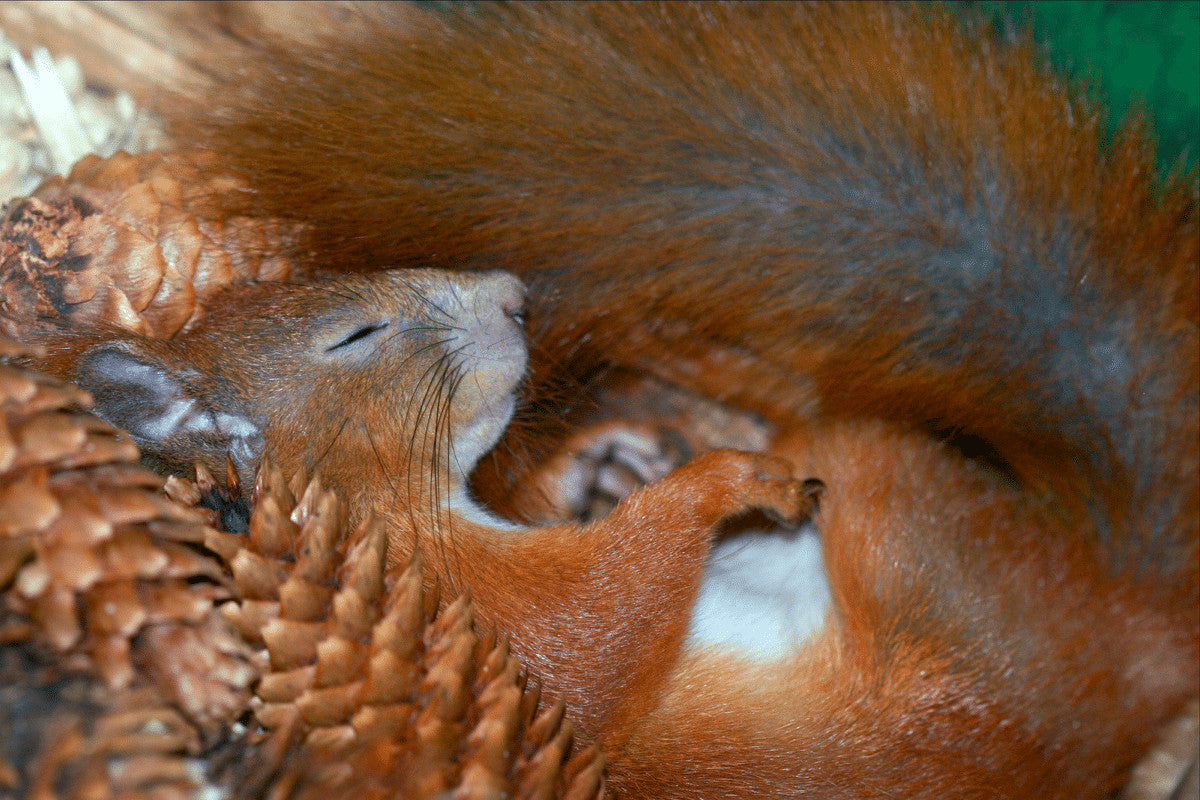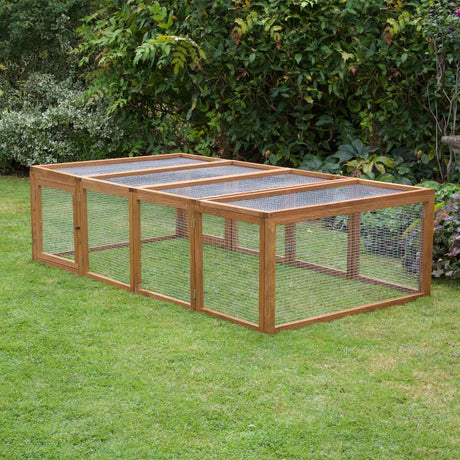In the late summer and autumn, squirrels seem to be everywhere in our local woods: flying through the trees, sitting bold as brass in the middle of paths nibbling on acorns. But come the winter, the squirrels are nowhere to be seen. Are they hibernating? If not, what do squirrels do in winter?

Do Squirrels Hibernate?
We humans may think of hibernation as just curling up in the warm and getting your head down during the cold weather. But in the animal kingdom, there's a lot more to it than that.
What Is Hibernation?
Hibernation is a pretty amazing strategy to allow animals to survive though adverse conditions, typically the winter.
Several UK mammals hibernate - hedgehogs most famously, but also bats and dormice.
During hibernation, an animal's metabolism slows down so that it uses only a tiny fraction of the energy it would whilst active.
So, for example, a hibernating hedgehog's temperature drops to less than 10c, its heart will beat only a few times a minute, and it can get by on taking just a few breaths each hour.
The result is that a hibernating creature can survive for several months on the energy reserves, which would last just days whilst active.
This is pretty handy during the winter months when there may be little or no food to be had. But even so, a creature that intends to hibernate must build up huge fat reserves to see them through the winter. Hibernation can be a dangerous strategy, and many animals die each winter whilst hibernating.
So Can Squirrels Hibernate?
The short answer is that it depends on what sort of squirrel you're talking about. Ground squirrels do hibernate, but tree squirrels don't. The squirrels we have here in the UK, red and grey squirrels, are both tree squirrels. So In the UK, squirrels don't hibernate. However, they are out and about much less during the winter months.
Why Don't Red and Grey Squirrels Hibernate?
No one really knows why some animals are adapted to hibernate through the winter, and others aren't. But with the squirrel, there are a couple of pointers we can consider.
First of all, an animal that plans to hibernate needs to put a lot of weight before bedding down for the winter. A hedgehog, for example, can lose up to a third fo its body weight during hibernation. So a hog needs to be pretty fat before it can safely hibernate for the winter.

Scientists speculate that arboreal creatures like tree squirrels just wouldn't be able to put on the required amount of weight. Running through the trees is a highly energy-intensive activity, and if the squirrel did manage to put on the necessary weight, would it then be too fat to move through the branches?
This is an interesting idea, but it doesn't stand up to examination. Squirrels do actually put on a fair bit of weight in the autumn: reds up to 12% of their body weight and greys up to a hefty 25%.
And bats and even some species of birds hibernate. They don't just have to climb trees; they fly - which is even more energy-intensive.
Another theory that seems more credible is that creatures who hibernate do so in expectation of famine. Going back to hedgehogs as our example, they are insectivores. Their primary diet is insects, and as we know, there are very few insects around in the winter.
Squirrels, on the other hand, are herbivores. They eat plant matter with a big focus on nuts, seeds, and berries. Although these foods might be harder to find in the winter, they certainly don't disappear altogether. In fact, nuts, seeds and berries are a primary food source for many of our native birds over the winter.
So British squirrels have no real danger of starving to death during an average winter, so no need to hibernate.
So How Do Our Squirrels Get Through the Winter?
Although red and grey squirrels in the UK don't face starvation during the winter, it's still a tough time. Food, though not absent, is scarce and can be more difficult to find in inclement weather conditions.
More importantly, it's cold. As the air temperature drops, mammals must use more and more energy just to keep warm. For small mammals like squirrels, this is even more of a challenge.
So how exactly do squirrels get through the winter?
Laying Down Supplies
One of the things squirrels are most famous for is burying nuts. Although they do this all year round, activity increases in late summer and autumn as they lay in their stores for winter.
A single squirrel can set up over a thousand "larders" containing nuts, seeds, bones and even dried mushrooms! The squirrel typically scatters the larders around their nests in their home range. They go to some lengths to put other aminals off the trail of where they have buried their supplies. They have been observed to do "phantom digging" if they think they are being watched. Or even bury stones instead of food.

No one knows quite how squirrels find their stashes, often months after burying them. There is a theory that squirrels memorise landmarks and use these as a map to pinpoint their stores later.
Squirrels also have a fantastic sense of smell and have been known to sniff out a larder buried under a foot of snow.
Even with these super-senses, squirrels don't ever find all of their stores. About a quarter of the food they stash is taken by other animals each year. And other larders are just forgotten, leaving the seeds to grow into new plants.
This wastage means that each year the squirrel has to collect and store about three times as much food as it will actually eat.
Fatten Up
As well as laying down food supplies for the winter squirrels lay down a layer of winter fat too.
Our red squirrels add around 12% to their body weight in the run-up to winter, with greys putting on 25%.

This extra fat serves two purposes. It acts as insulation, keeping them warm as with air temperature drops. And fat reserves can also be called on for energy should food become scarce during the coldest months.
Wrap Up Warm!
Squirrels live in nests called drays. The nests they build for the summer months are quite scrappy affairs. They can even just take over abandoned rooks nests and put a roof on them.
The winter dray is a more sophisticated setup. Winter drays are built in the branches of trees by reds, and more often, in holes in tree trunks by greys. They are at least 12 inches across and spherical. And they are built for warmth.
The outside of a winter dray is usually constructed of twigs with the leaves still on. Under this, there are many layers of leaves, often oak, laid flat to create multiple layers of insulation.
Inside that, there will be a couple of inches of soft moss, feathers, shredded bark and thistledown. And then the central chamber where the squirrel gets cosy.
The final layer of insulation is that tail, which they wrap around themselves like a blanket.
Research has shown that the inside of a winter dray and be 20 - 30c warmer than the surrounding air temperature. They rarely drop to freezing inside, even when the squirrel is absent. And when a squirrel returns to its dray, it only takes between 10 and 30 minutes for the dray to get back up to a very cosy 25c.
Lay Low.
The final part of the squirrels' winter survival plan is to spend as much time indoors as possible.
Squirrels are active for up to 11.5 hours each day during the summer months. In winter, this falls to 4.5 hours at most.
During the winter months, squirrels stick to their drays as much as possible, venturing out to retrieve food from only the most local larders when the weather is at its worst.
And whilst squirrels are generally solitary creatures in winter, they will share nests for extra warmth.
Squirrels - Not Hibernating, But Certainly Cosy in the Winter.
So despite what we may have thought, tree squirrels in the UK don't hibernate in winter. They don't need to; they have other strategies for making it through the cold months.
A combination of conscientious food storage and plenty of insulation works just as well for squirrels as hibernation does for other animals.

The winter months are a challenge for all our wildlife, but the squirrel certainly seems to be well prepared.
We hope you've found this article interesting and useful. Do you have questions or suggestions? We'd love to hear them. Leave us a comment below.









4 comments
I read this post as a student studying zoology. It has some helpful information that aids me in finishing my project. I appreciate you giving such helpful information. I think it may be amazing Do bearded dragon eat their shed
I am a zoology student and I read this post. It contains a piece of useful information that helps me in my project. Thanks for sharing such kind of useful information. You should also read about the How many hearts does an ostrich have
Just thought you might be interested to know ,we have black squirrels here in Letchworth Hertfordshire.
Very interesting and informative article. Many thanks. We have red squirrels locally (UK, Mersea Island) which have been introduced in recent years and are successfully breeding. We have one resident nearby who has spent the autumn raiding our hazel bush of all its nuts. I managed to catch him (or maybe her) in the act using a Trail Cam. He was seen on almost a daily basis until a few weeks ago, since when he has been much less in evidence. Was seen today though (9/11/2021).